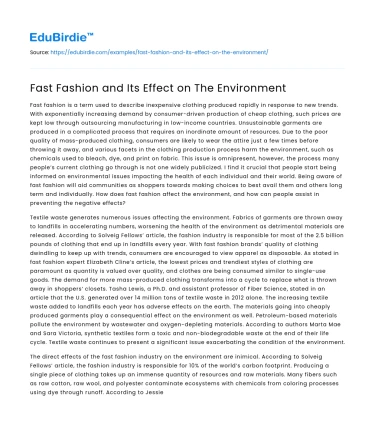Fast fashion is a term used to describe inexpensive clothing produced rapidly in response to new trends. With exponentially increasing demand by consumer-driven production of cheap clothing, such prices are kept low through outsourcing manufacturing in low-income countries. Unsustainable garments are produced in a complicated process that requires an inordinate amount of resources. Due to the poor quality of mass-produced clothing, consumers are likely to wear the attire just a few times before throwing it away, and various facets in the clothing production process harm the environment, such as chemicals used to bleach, dye, and print on fabric. This issue is omnipresent, however, the process many people’s current clothing go through is not one widely publicized. I find it crucial that people start being informed on environmental issues impacting the health of each individual and their world. Being aware of fast fashion will aid communities as shoppers towards making choices to best avail them and others long term and individually. How does fast fashion affect the environment, and how can people assist in preventing the negative effects?
Textile waste generates numerous issues affecting the environment. Fabrics of garments are thrown away to landfills in accelerating numbers, worsening the health of the environment as detrimental materials are released. According to Solveig Fellows’ article, the fashion industry is responsible for most of the 2.5 billion pounds of clothing that end up in landfills every year. With fast fashion brands’ quality of clothing dwindling to keep up with trends, consumers are encouraged to view apparel as disposable. As stated in fast fashion expert Elizabeth Cline’s article, the lowest prices and trendiest styles of clothing are paramount as quantity is valued over quality, and clothes are being consumed similar to single-use goods. The demand for more mass-produced clothing transforms into a cycle to replace what is thrown away in shoppers’ closets. Tasha Lewis, a Ph.D. and assistant professor of Fiber Science, stated in an article that the U.S. generated over 14 million tons of textile waste in 2012 alone. The increasing textile waste added to landfills each year has adverse effects on the earth. The materials going into cheaply produced garments play a consequential effect on the environment as well. Petroleum-based materials pollute the environment by wastewater and oxygen-depleting materials. According to authors Marta Mae and Sara Victoria, synthetic textiles form a toxic and non-biodegradable waste at the end of their life cycle. Textile waste continues to present a significant issue exacerbating the condition of the environment.
Save your time!
We can take care of your essay
- Proper editing and formatting
- Free revision, title page, and bibliography
- Flexible prices and money-back guarantee
The direct effects of the fast fashion industry on the environment are inimical. According to Solveig Fellows’ article, the fashion industry is responsible for 10% of the world’s carbon footprint. Producing a single piece of clothing takes up an immense quantity of resources and raw materials. Many fibers such as raw cotton, raw wool, and polyester contaminate ecosystems with chemicals from coloring processes using dye through runoff. According to Jessie O’Driscoll’s article, fibers such as nylon require water usage of up to 3,860 liters per kilograms and 150 megajoules per kilogram with several million tons of demand. Toxic wastewater and effluent are formed from the manufacturing process and produce high levels of air pollution. Untreated wastewater from dyes is often discharged into local water systems, releasing toxicants harmful to nearby residents and animals. Heavy pesticides and fertilizer used in resources to make certain fibers lead to reduced soil fertility and a loss of biodiversity.
While the fast fashion industry possesses a great threat to the health of the environment, there are numerous ways consumers can choose to shop smarter and lessen their support to environmentally unfriendly practices. One method that would make an impact is reducing purchases for clothing. According to the Oxfam charitable organization, the emissions from all the new clothes bought in the UK each month are greater than those from flying a plane around the world 900 times. Limiting purchases of attire to necessities of sustainable quality and timeless styles allows shoppers to save money and reduce their carbon footprint. Another alternative for consumers is to thrift. Second-hand garments provide an inexpensive option for people to recycle clothing and prevent having to purchase new, unsustainable garments. Alternatives remain present to fibers that are environmentally unfriendly as well. In Jessie O’Driscoll’s article, looking for fibers organically grown, degummed in factories with strict effluent treatment protocols, choosing recycled fabrics without catalytic agents, or substituting harmful fabric materials such as nylon and acrylic with natural fibers such as wool are all beneficial solutions to buttress slow fashion.
Unsustainable clothing instigates excessive amounts of issues towards the environment due to several causes. Large amounts of clothing are thrown away to landfills annually, and fabrics may take up to several hundred years to degrade, polluting water and air with toxic chemicals from bleach and carbon dioxide releasing chemicals. The environment is directly impacted as ecosystems perish from high emissions of carbon dioxide affecting climate and habitat conditions. Staying informed and educated on substantial issues such as fast fashion’s influence through an environmental aspect guides shoppers to make wholesome choices. Shopping sustainably aids in preventing pernicious effects towards the quality and survival of people’s lives. Every individual as a shopper can use information known about pollution from the fast fashion industry to stay aware of the consequences of specific purchases from various sources.






 Stuck on your essay?
Stuck on your essay?

